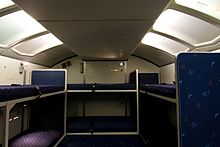Crew rest compartment
A crew rest compartment (crew rest) is a section of an airliner dedicated for breaks and sleeping by crew members, usually located above or adjacent to the passenger compartment.[1] Crew rest compartments are normally segregated, with separate compartments for the flight crew and the cabin crew.[2]

On long flights, crew members may sleep in crew rest compartments during off-duty periods.[3] Federal Aviation Regulations have provisions requiring crew rest areas be provided in order to operate a long flight by using multiple crew shifts.[4]
Passengers are restricted from accessing crew rest compartments by regulations; their entrances may be secured by locks and may require ascending a ladder for access.[5]
Crew rest compartments may not normally be used during taxi, takeoff, or landing maneuvers (TT&L).[6] In flight crew rests that contain standard seats, an exception may be made to allow seated crew during TT&L.[7]
In the United States, the Federal Aviation Administration (FAA) defines three classes of crew rest facilities, dependent on the number of crew and the duration of the flight.[8] Crew rest periods may be provided in higher classed rest areas than required, for example some airplanes may not have a class 2 rest facility, providing breaks in a crew rest.

The FAA rest facility classifications from highest to lowest:
- Class 1 rest facility: This class requires access to an area physically separated from the cockpit and the passenger cabin; contain bunks or other flat areas for sleeping; have provisions for sound and lighting isolation.
- Class 2 rest facility: This class requires access to at least a lie flat seat and separation from passengers by a curtain.
- Class 3 rest facility: This class only requires a cabin seat that is able to recline and has foot support.
Crew rest design and safety considerations are similar between international regulators, for example the European Aviation Safety Agency (EASA) regulations for access control, communications, and signage are similar to those of the FAA's.[9] By following such regulatory Bilateral Aviation Safety Agreements (which avoid contradictory minimum specifications), aircraft manufacturers can design crew rests to meet the requirements in many markets.
Aircraft with crew rest compartment[]
- Airbus A330/-200/-300/-800/-900
- Airbus A340/-200/-300/-500/-600
- Airbus A350/-900/-1000
- Airbus A380/-800
- Antonov An-124
- Boeing 747-400/-400ER
- Boeing 747-8
- Boeing 767/-200ER/-300ER/-400ER
- Boeing 777/-200ER/-200LR/-300ER
- Boeing 787/-8/-9/-10
- Tupolev Tu-114
References[]
- ^ Schneider, Kate. "Inside the part of the plane you can't see". news.com.au. Retrieved 26 July 2016.
- ^ "Federal Register | Special Conditions: Airbus, Model A350-900 Series Airplane; Crew Rest Compartments". www.federalregister.gov.
- ^ www.catchmeifyoucannie.com, Annie Kingston (21 January 2016). "The Reality Of Being A Flight Attendant". The Huffington Post. Retrieved 26 July 2016.
- ^ George, Fred. "Preventing Crew Fatigue from A to Zzz". aviationweek.com. Business & Commercial Aviation. Retrieved 26 July 2016.
- ^ Brown, David (13 October 2014). "Inside Look: Crew Rest Areas on Different Airliners - AirlineReporter". Airline Reporter. Retrieved 26 July 2016.
- ^ "Federal Register | Special Conditions: Airbus, A350-900 Series Airplane; Crew Rest Compartments". www.federalregister.gov.
- ^ "Special Condition D-04" (PDF).
- ^ "Advisory Circular AC 117-1" (PDF). Federal Aviation Administration. Retrieved 26 July 2016.
- ^ "Special Condition D-04 - Crew Rest Compartment" (PDF). EASA. Retrieved 23 July 2020.
External links[]
| Wikimedia Commons has media related to Aircraft crew rest areas. |
- Aircraft cabin components